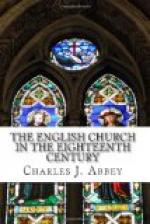circumstances, lose its temporary supremacy. In
the eighteenth century there were, from beginning
to end, men of each of these three sections.
The old Puritanism was almost obsolete; but there
were always Low Churchmen, not only in the earlier,
but in the modern sense of the word. High Churchmen,
in the seventeenth-century and Laudean meaning, were
no doubt few and far between by the time the century
had run through half its course. But they were
not wholly confined to the Nonjuring ‘remnant,’
and High Churchmen of a less pronounced type never
ceased to abound. Broad Churchmen, of various
shades of opinion, were always numerous. Only
each and every party in the Church was weakened and
diluted in force and purpose by a widespread deficiency
in warmth of feeling and earnestness of conviction.
Hot party feeling is no doubt a mischief; but exemption
from it is dearly bought by the levelling influences
of indifference, or of the lukewarmness which approaches
to it. The Church of the eighteenth century, and
of the Georgian period in general, was by no means
deficient in estimable clergymen who lived and died
amid the well-earned respect of parishioners and neighbours.
But the tendencies of the time were in favour of a
decent, unexacting orthodoxy, neither too High, nor
too Broad, nor too Low, nor too strict. It may
be well imagined that this feeling among the clergy
should also find outward expression in the general
character of the churches where they ministered, and
of the services in which they officiated. A traveller
interested in modes of worship might have passed through
county after county, from one parish church to another,
and would have found, as compared with the present
time, a singular lack of variety. No doubt he
would see carelessness and neglect contrasting in
too many places with a more comely order in others.
He would very rarely notice any disposition to develop
ritual, to vary forms, and to make use of whatever
elasticity the laws of the Church would permit, in
order to make the externals of worship a more forcible
expression of one or another school of thought.
Our forefathers in the eighteenth century were almost
always content to maintain in tolerable, or scarcely
tolerable repair, at the lowest modicum of expense,
the existing fabrics of their churches. It has
been truly remarked, that ’to this apathy we
are much indebted; for, after all, they took care
that the buildings should not fall to the ground; if
they had done more, they would probably have done worse.’[838]
For ecclesiastical architecture was then, as is well
known, at its lowest ebb. ‘Public taste,’
wrote Warburton to Hurd in 1749, ’is the most
wretched imaginable.’[839] He was speaking, at
the time, of poetry. But poetry and art are closely
connected; and it is next to impossible that depth
of feeling and grandeur of conception should be found
in the one, at a date when there is a marked deficiency
of them in the other. There were, however, special




